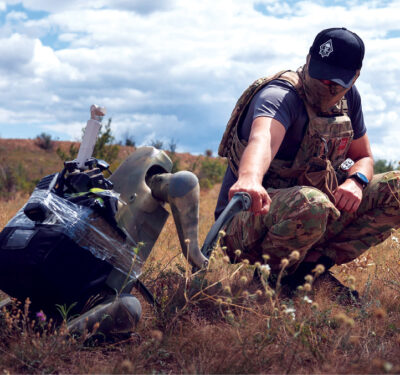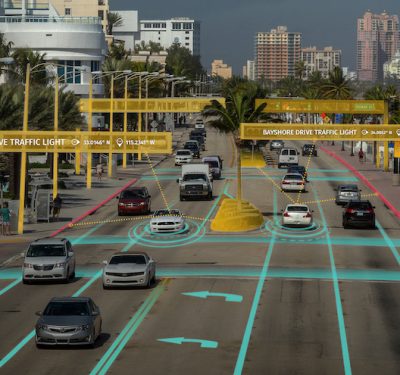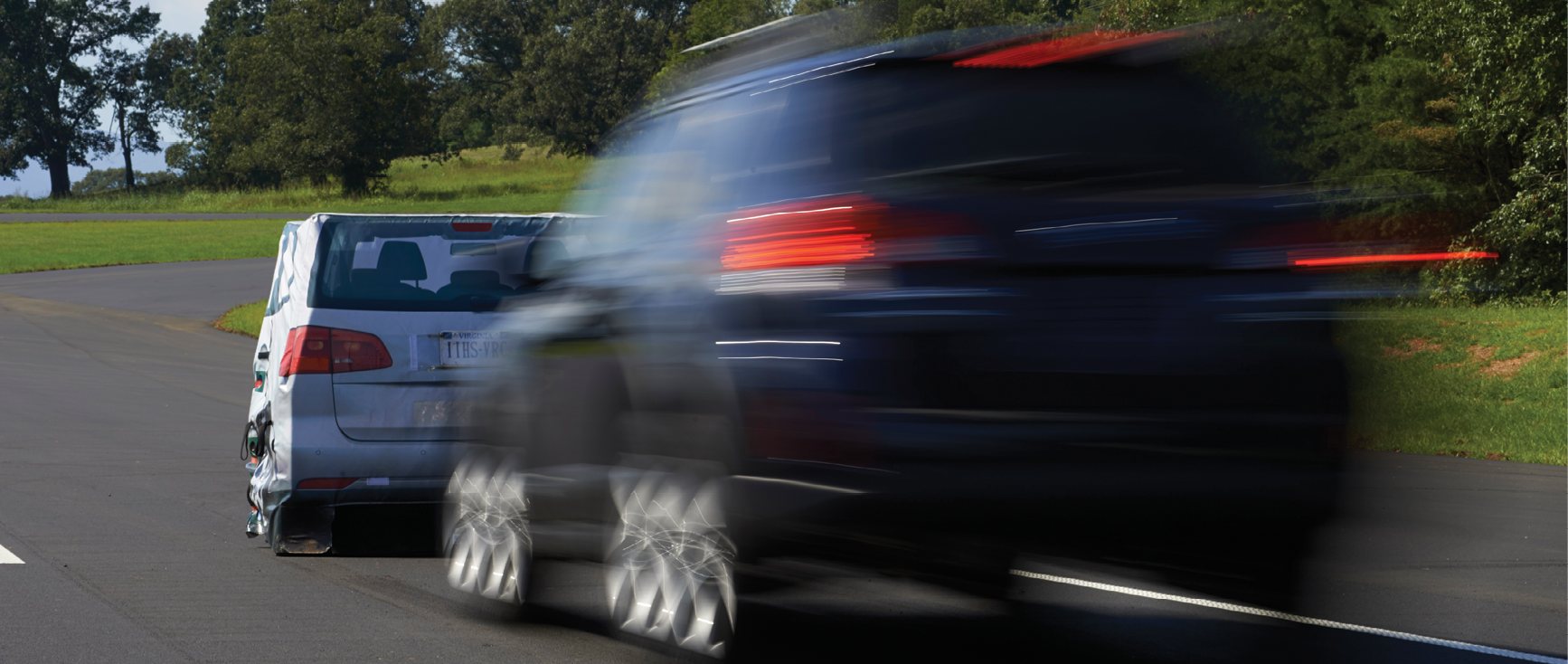
Perrone Robotics
The roadways can be a dangerous place. Distracted drivers, congestion and unexpected obstacles all contribute to traffic accidents and even deaths—with more than 32,000 people in the U.S. losing their lives in car accidents in 2010, and another 2.4 million sustaining injuries, according to the World Health Organization.
The Insurance Institute for Highway Safety strives to reduce those numbers, and make the roads a safer place to travel. Since they first opened the Vehicle Research Center (VRC) in 1992, they’ve focused on testing and then rating vehicles on a variety of safety features, information consumers often use when deciding which car to buy.
The IIHS is the organization behind those famous crash test dummy videos that helped bring the importance of vehicle safety to the public’s attention. But as the technology in today’s cars evolves, so must the organization’s methods of testing.
For the last two years, IIHS has worked with Virginia-based Perrone Robotics and the Australian firm Locata to develop a way to test autonomous collision avoidance features. Already available in cars today, collision avoidance systems can warn drivers when they’re getting too close to another car or drifting out of their lane. Some vehicles also have automatic braking to avert accidents.
“More and more automakers are fitting cars with systems that intend to help drivers avoid crashes,” said David Zuby, IIHS’s executive vice president and chief research officer. “Our organization has a long history of promoting advancements that reduce car crashes, so we want to be in a position to evaluate these systems as they become more available on the marketplace.”
IIHS is now entering the production phase of the Autonomous Vehicle Test System or AVTS, which uses robotics to conduct the precise, repeatable tests necessary for evaluating and comparing these emerging technologies. The AVTS, which itself should be ready for testing by the end of 2015, is designed to accelerate IIHS’s evaluations and ensure that vehicle collision avoidance systems can safely and predictably operate on the roadways, said Paul Perrone, founder and CEO of Perrone Robotics.
AVTS Components
The Autonomous Vehicle Test System consists of four key elements—the Test Vehicle Drop-In Actuator Kit (DAK), target robots, AVTS software and a positioning system provided by Locata.
Using robotics for testing is more efficient because the IIHS staff will be able to know, without a doubt, that each test is performed in the exactly the same way, every time, Zuby said. Human drivers simply can’t do that.
“The main goal is to enable us to carry out repeatable and precise tests of the crash avoidance technology that’s in the cars we drive,” Zuby said. “These tests will help us understand how these systems work and eventually enable us to offer guidance to consumers and to the auto industry about which systems work better than others.”

The AVTS was developed based on requirements from the Institute for Highway Safety. Perrone Robotics
The Robotics
The DAK, one of two robotic platforms that make up the AVTS, can be installed in any car in 30 minutes or less, Perrone said. The kit attaches to the steering wheel, brake and throttle and allows the test driver to sit in the passenger seat as the robot steers the car.
The DAK ties into a box that can be stored in the trunk, back seat or passenger seat, he said. That box houses the electronics that provide the data from various sensors, including speed sensors, the Locata positioning system as well as a heading sensor that lets testers know where the vehicle is so it can navigate according to a pre-defined path or a sequence of maneuvers.
The second robot is basically a dummy car, Perrone said, or balloon car that test vehicles can crash into without sustaining damage. This target robot is a mobile platform that carries a soft, crashable target and presents itself to the test vehicle as another automobile.
This dummy car can support collisions of up to 55 mph and if the test car and target robot collide, the test vehicle simply bumps into the soft target and drives over the robotic platform.
“You can have any number of robotic vehicles or test vehicles, IIHS can set up any kind of test they want at actual highway speeds in their outdoor track or on the expanded indoor track they’re building,” Perrone said. “The vehicles can communicate their positions to one another and modulate their speed based on information from the other vehicles.”
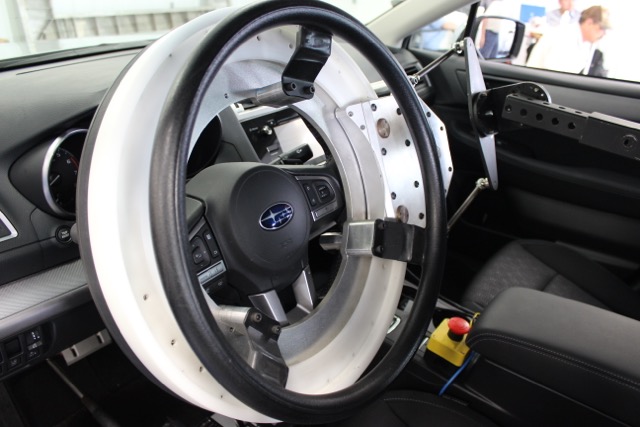
Perrone Robotics
The Software
Perrone Robotics first began developing the software used in the AVTS in 2001, Perrone said, with the goal of creating a general purpose software platform for mobile robotics. They put that software to the test in 2005 when they entered the DARPA Grand Challenge, which tasked teams with building a self-driving ground vehicle able to travel across the Mojave Desert.
Perrone continued to hone its software, entering a second DARPA challenge in 2007. This time they had to develop a self-driving vehicle that could navigate an urban setting and do everything a human would do including avoiding other vehicles and stopping at intersections.
Since then Perrone has continued to evolve the software, which has been used in projects ranging from adding automation to Neil Young’s “LincVolt” hybrid-converted 1959 Lincoln Continental to a military program involved in automating a Polaris Ranger ATV.
The AVTS software is an extension of those projects, Perrone said, and contains the same DNA and the same capabilities to perform just about any maneuver necessary with high precision. The software defines and controls the tests, as well as transfers and reviews data. Each target robot and DAK includes an embedded computer that runs the software for autonomous self-navigation and bot-to-bot communication for precise coordination of relative positioning and logging data.
“You can program it to do anything really, from self-parking to merging,” Perrone said. “It’s really great to see this software come into its own in an application where it’s not just very, very useful, but where it’s also going to help save lives.”
The Positioning
To successfully test current and future collision avoidance technology, IIHS needs to be able to achieve very accurate measurements of each vehicles’ position on the test track, as well as the vehicles’ positions relative to one another. Instead of relying on GPS for positioning, which can be obstructed by trees and impacted by other factors like jammers; Zuby and his team decided to use Locata, an independent, ground based positioning system that offers precise, reliable, local positioning.
IIHS is also building an indoor test track, which eliminates the possibilities of using GPS altogether, said Geoff Hoekstra, Business Development Manager for Perrone Robotics. With Locata, they can take precise measurements at both the outdoor and indoor tracks. Locata worked with Perrone Robotics to optimize the system to 10 cm accuracy, a fairly common benchmark for this type of testing.
“The key reason for that is repeatability in testing,” Perrone said. “You want collision points to happen as identically as possible. You need precision and control for repeatability and fairness in testing.”
Perrone reached out to Locata based on the IIHS requirements, Hoekstra said. They needed a local system they could control for the best possible test results.
Nunzio Gambale, CEO of Australia-based Locata, came out to the Virginia facility last summer for the first public demonstration of the system. The Locata installation achieved 4 cm precision accuracy during the demonstration, Gambale said, in both the vehicle under test and the collision target robot.
“It’s essential you have something you can bet your life on in terms of positioning accuracy and reliability,” said Gambale.
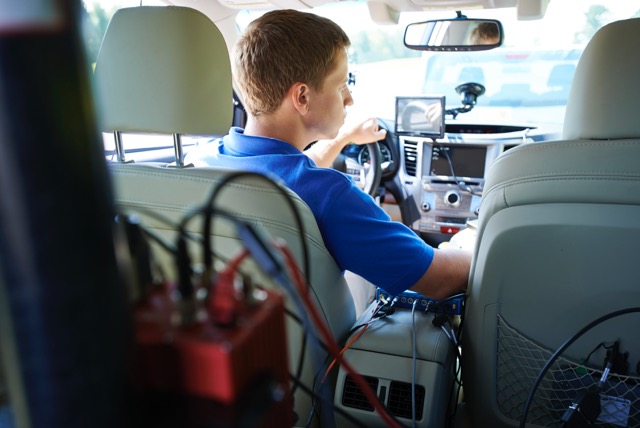
Photo courtesy of IIHS
Getting A Head Start
Even though the AVTS isn’t quite finished, IIHS has already begun using the Locata system and the target robot to test and rate front crash prevention systems. These systems give warnings when a car is about to crash, and automatically apply the brake if the driver doesn’t respond fast enough.
They’re now testing these systems by putting the target robot in the middle of the test track, then driving the test vehicle toward it and evaluating what happens, Zuby said. While this is a great first step, this type of simplistic test won’t tell Zuby and his team everything they need to know about the technology, especially as it becomes more complex.
“That’s not the only kind of situation that occurs in driving. Sometimes you crash into the back of a vehicle because the vehicle in front of you slowed down very quickly. Or sometimes you crash into a vehicle that comes from another lane and cuts you off in heavy traffic,” Zuby said. “These are the situations we can’t test with a stationary balloon car but would be able to test with a robot guided target carrier. The more complicated you want to make the driving of the test car prior to the system’s intervention, the more you need to rely on a robotic driver who can do it exactly the same way every time.”
While Zuby is eager to put the full system into testing situations hopefully sometime this year, he’s happy with the results he’s seen in the development testing they’ve completed so far. The system controls the vehicle pretty well, he said, and after working out some initial bugs, the positioning data they’re gathering from the Locata system has been very reliable.

The Vehicle Research Center (VRC) has a 22,000 sq. ft. crash hall with three runways designed to replicate crashes into other vehicles or fixed objects. Photo courtesy of IIHS
The Benefits of Avoidance Collision Technology and Autonomy
Improved safety is one of the main benefits of collision avoidance technology, and that’s why Ed Hutchinson, manager of the Transportation Statistics Office at the Florida Department of Transportation Central Office (FDOT), is so encouraged by the AVTS and the testing being done at the Vehicle Research Center. It’s also why the department has become so involved in supporting the incorporation of partially and fully autonomous vehicles onto the roadways in both Florida and nationwide.
“The societal cost of traffic accidents is tremendous,” said Hutchinson, who is also the lead manager of the Florida Automated Vehicles program at FDOT. “The ability to save even one life is worth it, but the leaders in this field are telling us this technology has the potential to save quite a few lives. That’s really important.”
The department, which recently held its second Automated Vehicle Summit, is also conducting research of its own, including surveying the state’s seniors about autonomous vehicle acceptance and educating them about how it can benefit their lives. Autonomous technologies can help seniors continue to drive safely, improving their mobility and their quality of life, which Hutchinson sees as another great benefit of this technology.
Jordan Perch, a car tech specialist who regularly writes for DMV.com, agrees that by eliminating human error, vehicle automation can improve driving safety and reduce the number of traffic crashes and fatalities.
“Self-driving cars are equipped with sophisticated safety systems that consist of sensors, radars, cameras and on-board computers, which makes them capable of avoiding obstacles and collisions with other vehicles, pedestrians or cyclists,” Perch said. “With autonomous cars, risky driving behaviors, such as speeding, running red lights, driving under the influence, or aggressive driving, could well become a thing of the past.”
These systems also can reduce traffic congestion, cut carbon emissions, improve traffic flow and even improve air quality, Perch said.
Why Testing Is Important
More and more car manufacturers are introducing increased levels of autonomy to their vehicles, Hutchinson said, and in the next 10 years he expects just about every new car will feature some sort of autonomous technology.
“This technology is going to mirror what’s happened with the advent of the new smart phones and tablets. Once the public gets a taste of it they’re going to absolutely demand it,” Hutchinson said. “And the automobile manufacturers will respond to that by putting it into every vehicle. Testing is critical.”
And that testing, of course, must be consistent and repeatable so the results for different systems can be compared. Gambale said he’s proud his positioning system is helping to make that happen.
“You can’t put two cars with human beings in them, with their hands and feet off the controls going toward each other at 50 mph, and hope the system works. You need some form of robotic control,” Gambale said. “It’s critical every test is conducted in the exact same way, every time or the results can’t be compared. This is only going to get more and more important as we go from what we call vehicles with autonomous features that still have a driver to eventually having completely autonomous vehicles.”
The Future
Eventually, Hutchinson knows we’ll see a day when completely autonomous vehicles are integrated into our highways, but that day is pretty far off. And it’s not because the technology isn’t there. It is, and some vehicle manufacturers would like to see autonomous cars on the road in as little as five years. Others, like Hutchinson, expect various policy and legal issues to keep these cars parked for years to come.
It’s important, however, to prepare for the day when driverless cars do enter the roadways, and to find out which autonomous features work best, are the safest and best reduce the number of crashes on the roadways.
“AVTS will be able to test all the partial automation functions that are in vehicles on the market now,” Perrone said. “And then of course we can use the system in the future, as we march toward more and more vehicle automation, and eventually fully automated vehicles. We’ll be able to test these concepts in a repeatable fashion. Automated technology is going to accelerate the ability to test these collision avoidance systems that will reduce the number of auto accidents and deaths.”



